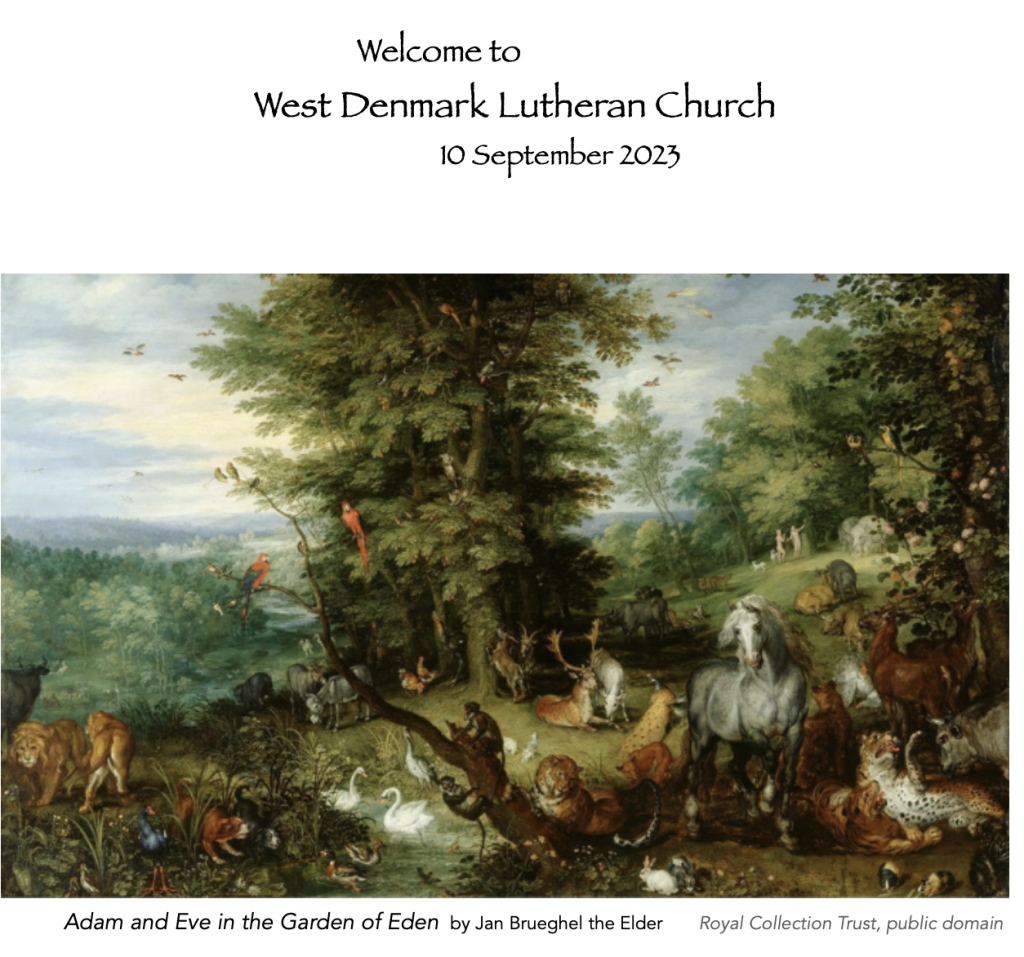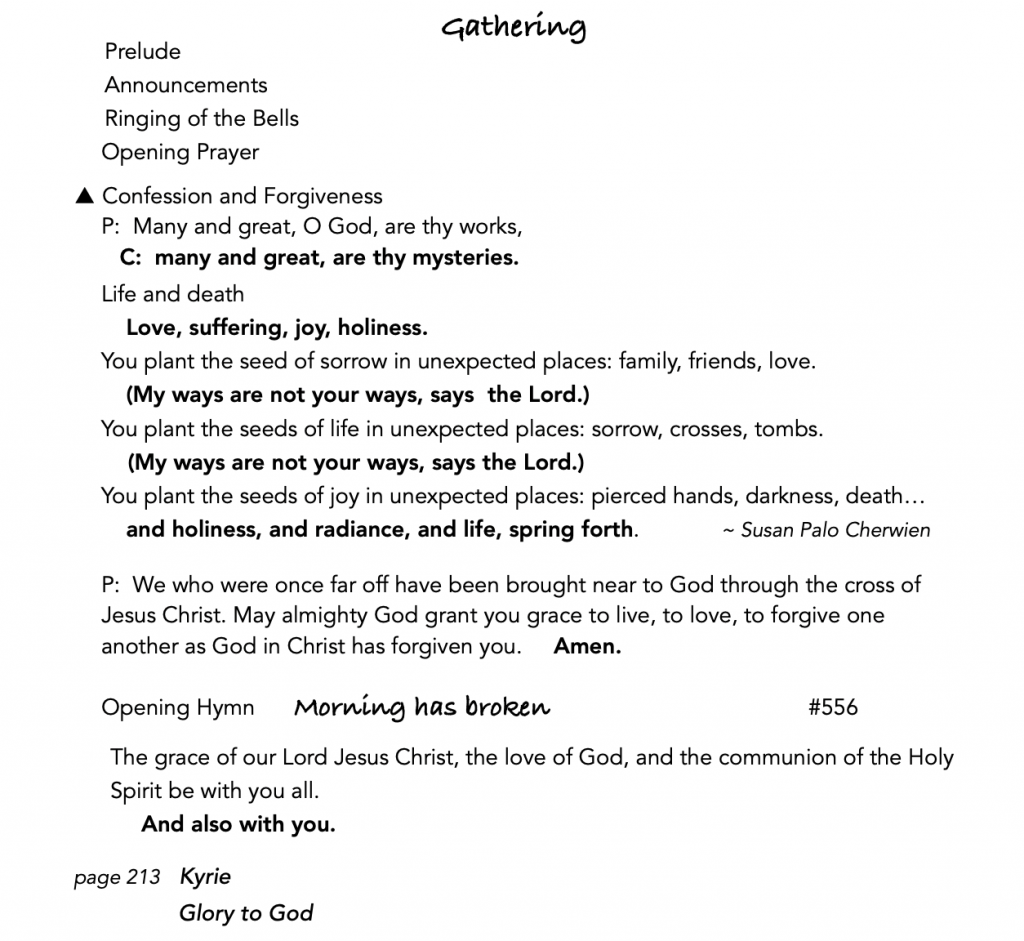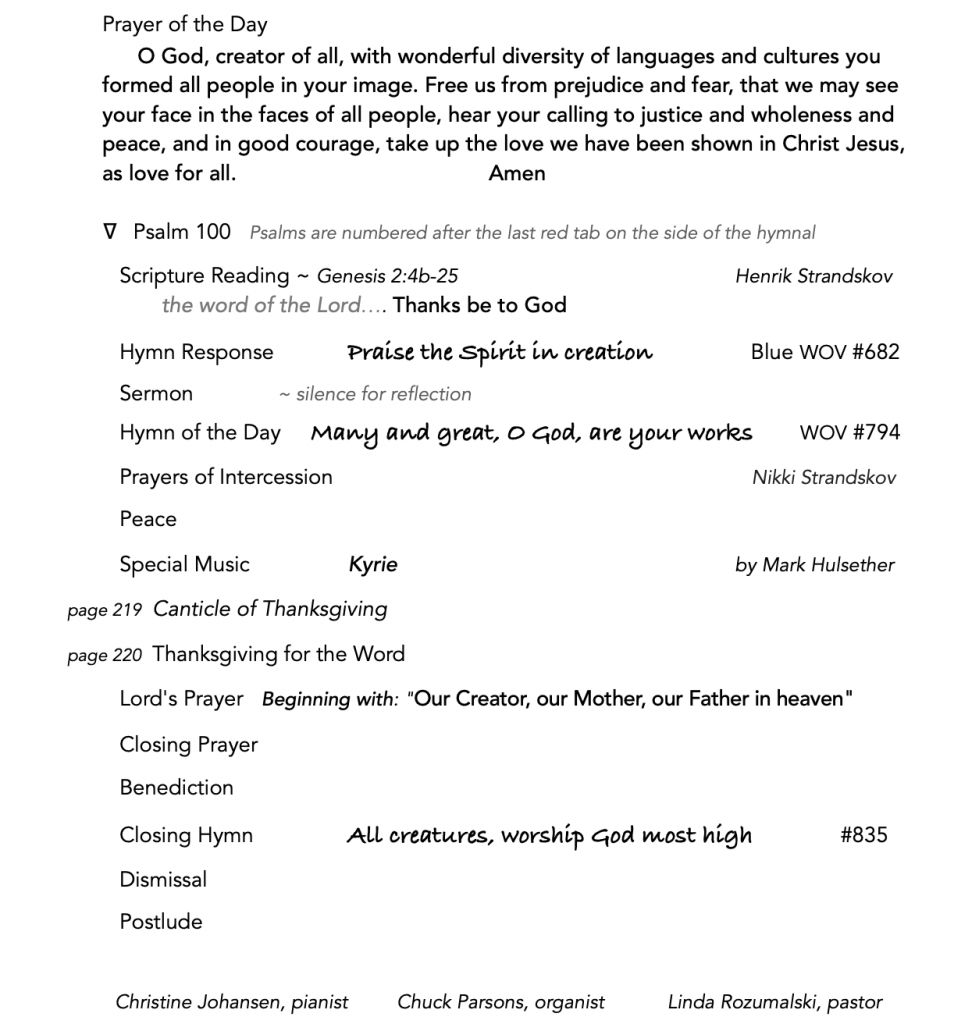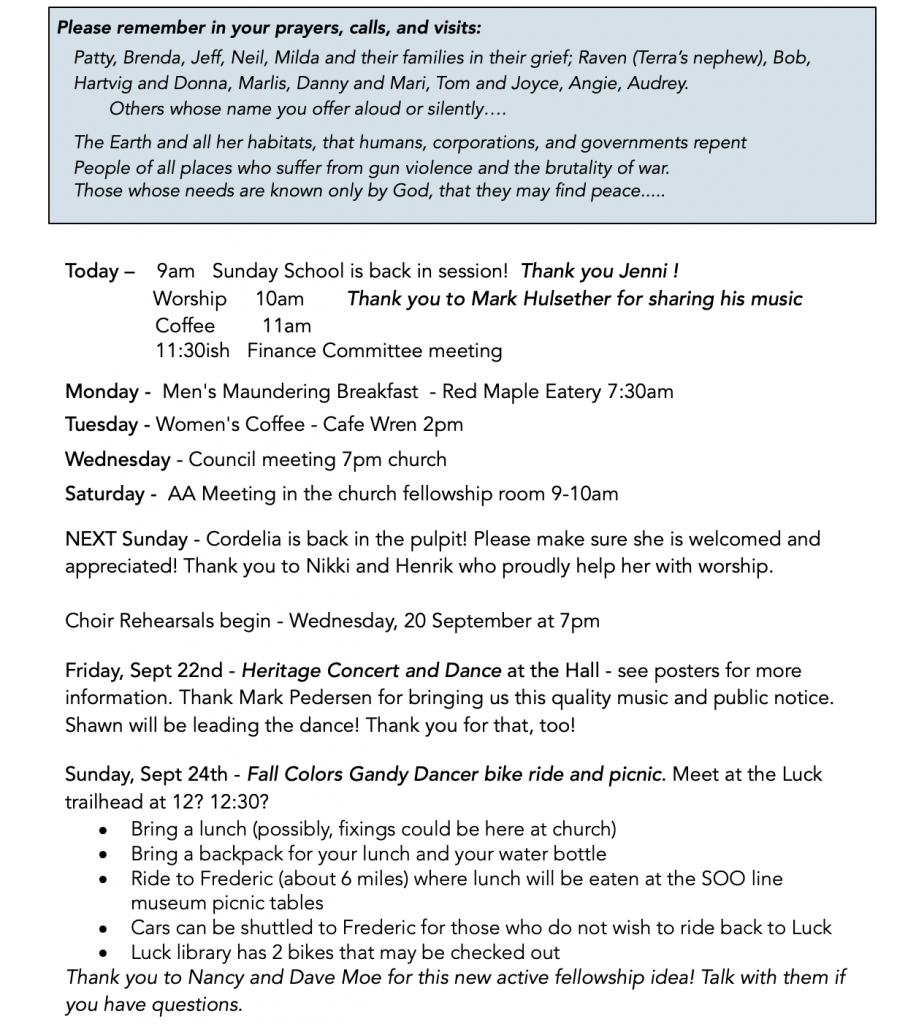


Today we begin again, in the cycle of scripture of the Narrative Lectionary. It is a four year collection of weekly readings from Genesis through the book of Acts highlighting a different gospel each year – (but not until Christmas). In these weeks of the Fall we will be in the Hebrew Scriptures that we call the Old Testament.
Today’s reading is the second of the two creation stories found in Genesis. Our challenge with familiar stories or passages is to hear what is actually said and not what we expect to hear. The two origin stories are very different and serve different functions, so, perk up your ears to hear this as if it is the only version of creation the Bible tells…
Genesis 2:4b-25
4These are the generations of the heavens and the earth when they were created. In the day that the Lord God made the earth and the heavens, 5when no plant of the field was yet in the earth and no herb of the field had yet sprung up—for the Lord God had not caused it to rain upon the earth, and there was no one to till the ground; 6but a stream would rise from the earth, and water the whole face of the ground— 7then the Lord God formed man from the dust of the ground, and breathed into his nostrils the breath of life; and the man became a living being.
8And the Lord God planted a garden in Eden, in the east; and there he put the man whom he had formed. 9Out of the ground the Lord God made to grow every tree that is pleasant to the sight and good for food, the tree of life also in the midst of the garden, and the tree of the knowledge of good and evil. 10A river flows out of Eden to water the garden, and from there it divides and becomes four branches. 11The name of the first is Pishon; it is the one that flows around the whole land of Havilah, where there is gold; 12and the gold of that land is good; bdellium and onyx stone are there. 13The name of the second river is Gihon; it is the one that flows around the whole land of Cush. 14The name of the third river is Tigris, which flows east of Assyria. And the fourth river is the Euphrates. 15The Lord God took the man and put him in the garden of Eden to till it and keep it.
16And the Lord God commanded the man, “You may freely eat of every tree of the garden; 17but of the tree of the knowledge of good and evil you shall not eat, for in the day that you eat of it you shall die.”
18Then the Lord God said, “It is not good that the man should be alone; I will make him a helper as his partner.” 19So out of the ground the Lord God formed every animal of the field and every bird of the air, and brought them to the man to see what he would call them; and whatever the man called every living creature, that was its name. 20The man gave names to all cattle, and to the birds of the air, and to every animal of the field; but for the man there was not found a helper as his partner.
21So the Lord God caused a deep sleep to fall upon the man, and he slept; then he took one of his ribs and closed up its place with flesh. 22And the rib that the Lord God had taken from the man he made into a woman and brought her to the man. 23Then the man said, “This at last is bone of my bones and flesh of my flesh; this one shall be called Woman, for out of Man this one was taken.” 24Therefore a man leaves his father and his mother and clings to his wife, and they become one flesh. 25And the man and his wife were both naked, and they were not ashamed.
The word of the Lord … thanks be to God.
You will have noticed that there are no days of creation in this version of the story. There is no orderly progression punctuated with God’s approval. The human is formed of dust (adamah, in Hebrew) and animated by God’s breath puffed into his nostrils on the same day that the earth and heavens were brought forth. The little guy was suspended in some way (I like to imagine he was put gently into God’s breast pocket) while God planted a garden in the East. East of what reference point, we might wonder, but, we are not told. From the same earth/adamah, God then fashioned trees – every tree that is pleasant to look at and good for food – and into the treeful garden the dustling, the adam, was placed. Adam and the trees, made of the same substance, preceded the plants and herbs—because the Lord God had not yet caused it to rain upon the earth, because, until Adam was made, there was no one to till the ground. So, immediately, we see that creation is meant to be intensely interactive, symbiotically mutual. God created both the human and the trees from the same adamah, breathed life into the man and, from that point on, trees and humans have been breathing together – what one exhales the other inhales (oxygen and carbon dioxide) – as though we have one lung, one breath, one life. And so we do.
The next thing to notice is that God gave the adam the task God had just completed. God created a garden and watered it, and then placed the little fellow in the garden to continue the work. God was not going to be the helper or workmate in gardening, nor was the human to be God’s little helper, but rather, God gave over the vocation of tending and tilling, entrusting the care of new creation – of plants and herbs and trees – to the brand new human being. The relationship between God and the human creature is not equal, but is, nevertheless, essential. The plants were not grown in the earth until the man was formed to tend them.
So, God watches this activity for a bit and then speaks the first word; “It is not good.”
In the first story of creative activity told in Genesis chapter 1, each of the seven days brings a new level of complexity, as it were, created through God speaking the Word, and as the sun sets on each new day, God declares, “It is good.”
That doesn’t happen in this version. That isn’t the backdrop to this story, and we must not mush the two together as though the two chapters move from cosmic scale to a close-up telling one tale. These are two unique traditions of creation told for two different reasons. I’ll get back to that in a little bit.
God watches the dustling work and says to herself, “It is not good for the man to be alone. I will make him a helpmate, a helper as his partner.” And so from the same ground, God fashions every animal of the field and bird of the air, one by one to see if it is a fit pairing. But, none is found among them. It is still “not good”.
If the ground fails to provide a suitable partner, then ‘like must come from like’. The word traditionally translated as “rib” is used in other places in scripture to mean “side” – so God takes the side of the first creation to make a pair, a match, which is why the two creatures cleave together, clinging to one another, to become, again, one flesh. The earthling, adam, made from the adamah, is now is called man, ‘ish, and his partner, made from him, is called woman, ‘ishah.
Everything about this account of creation is relational, reciprocal. That is its sense of order. Not only was the creation of the second human dependent on the body of the first, but the first human in their isolation was dependent on the creation of the second human to fill that relational void.
The next line puzzles me: 24″Therefore a man leaves his father and his mother and clings to his wife, and they become one flesh.” It is so clearly out of the storyline. Adam has no parents – other than God and mother earth – neither of whom he can, nor should, leave – and there is no mention of marriage, of the woman becoming a wife. This is a good example of biblical editing and is accepted as an awkward late arrival to the narrative imposing a later morality. It fits to some degree in that it, too, describes the move towards interdependence, a symbiotic relationship that forms in the new creation of a couple.
But, even given this awkward conclusion, the creation stories are about God, not humans. Human nature begins to heat up in the next chapter with the tree of the knowledge of good and evil. Here, it is God in the spotlight. Chapter one was written – or at least put into final form – after the Babylonian exile by what is called the Priestly tradition of redactors. It is about a sovereign God who is far above the earth’s political, human turmoil. Order and method are the world view. God, who creates space and stars and worlds with the power of a word, has chosen Israel to be the flag bearer. This view of God’s work was intended to unify and encourage the straggling, struggling people to stay in relationship with their God who is above all others, and not be seduced by the gods of Babylon. It was written, or edited, portraying the God of Israel as all powerful, all wise, the history of the world and the fates of her people all in hand. That image of God was vital for them, as it has been in various periods of time ever since for struggling, oppressed people.
Chapter two’s version that we heard today is older, told of Yahweh, the cultic, personal God of the Israelites who formed them as a people beginning with the call of Abraham, who rescued them and lead them out of slavery in Egypt personally in a cloud of fire and a cloud of smoke, who spoke to their leader, Moses, in person. This is a hands-on God who is near enough to hear, and move and comfort; to be with the chosen people. In this tradition, God works through adaptation, improvising to keep the future open.
If the whole cosmos is the scope of the first description of creation, it is the realities of the local arid earth that concern the narrator of the second story, land that needed a gardener before it could be watered, a gardener in need of a partner. And so we can see here the dual concepts of transcendent and immanent – of God over all and God within all, illustrated back to back in the first two chapters of the bible. Which should make it clear that there is not one correct way of believing or imagining God at work in our lives. There are likely infinite ways. The important part of it, to me, is to see the stories as independent and not a mash-up, in order to hear the particular truths they have to speak.
In our time and world, it is perhaps more vital to hear the second story, to hear the interrelatedness of human and earth, the breath of God in our nostrils and the breath of trees filling our lungs, of helpmates in the animal world not being soul mates, but still equal to us in creation, not hierarchically beneath us – maybe the first instance of separate but equal. It is important in our time to watch God evaluate and problem solve, to change course and keep trying to work with an increasingly strong-willed creature. It is important to hear again that creation was not made for us, for our benefit or pleasure or entertainment, but, rather, that we were created to serve. Psalm 8 claims mortals were made just a little less than divine, with all the works of God’s hands under our feet to rule and subdue them. The Yahweh writers could not agree less. If we cling to our human partners in mutual need, we must at the very least honor the life and rights of our fellow creatures, take our knee off their backs, and let them breathe.
These are the stories that lie ahead of us as we begin again in the beginning.
Pastor Linda
